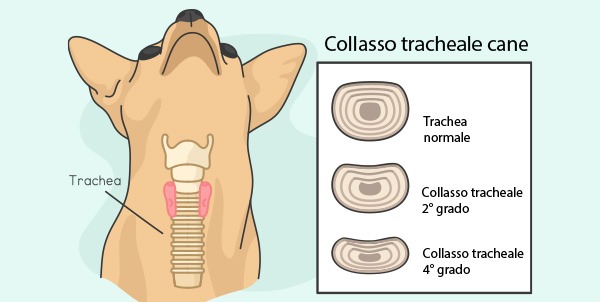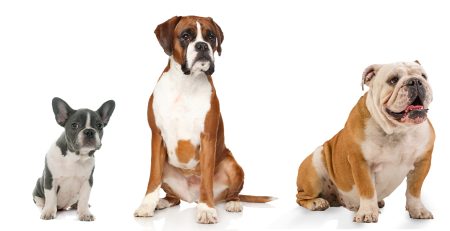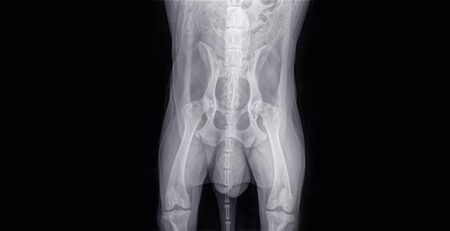Tracheal collapse (CT) in dogs consists of a respiratory failure syndrome due to crushing of the trachea.
The dog’s trachea, made up of small cartilaginous rings, is the channel that connects the throat to the lungs and through which air passes.
A weakening of the tracheal rings results in them collapsing in on themselves and no longer being able to ensure the normal conformation of the trachea and, consequently, proper breathing.
Symptoms of tracheal collapse in the dog
Deformation of the trachea results in decreased incoming airflow.
The most common clinical sign in dogs with tracheal collapse is a cough, which is dry and deep, known as a “duck-like” cough.
Also, shortness of breath, wheezing and difficulty breathing.
The dog’s air hunger, in cases of acute respiratory failure, can degenerate and cause dejection, cyanosis and even fainting.
The causes of tracheal collapse in the dog
While undoubtedly the disease is dystrophic in origin i.e. resulting from structural and functional degeneration of the trachea, it is also true that the causes remain unknown.
However, there are predisposing factors such as race predisposition and obesity.
In fact, a dog suffering from obesity has greater difficulty in breathing.
The most affected individuals generally belong to small and very small breeds: Chihuahuas, Dwarf Poodles, Pomeranian Foxes, Yorkshire Terriers.
This does not exclude, however , thattracheal collapse can affect a dog regardless of size or breed and to a greater or lesser degree.
Classification of the degrees of tracheal collapse
The classification of the different degrees of tracheal collapse in the dog and thus, its severity, is based on the percentage of reduction in the inner caliber of the tracheal rings.
Grade I: 25% reduction
Grade II: 50% reduction
Grade III: 75% reduction
Grade IV: 90% reduction
Diagnosis and treatment
The veterinarian will take the dog for radiography and endoscopy to determine the severity of the collapse and its location.
As long as the disease is in one of the first three grades, drug therapy is used, and only for the fourth case is surgery required.
The surgery consists of either reconstructing the trachea or placing a stent i.e., a retractor inside it: the stent supports the tracheal walls, preventing them from collapsing and allowing the dog to breathe normally.
Unfortunately, tracheal collapse is a chronic, progressive and irreversible condition , but delaying its complications and preventing its aggravation allows the dog a good quality of life.
If neglected, tracheal collapse can trigger bronchitis, tracheitis, or even pulmonary hypertension, which in the long run can develop into heart failure.
Precautions and precautions if your dog suffers from collapse of the trachea
In addition to the drug therapy prescribed by your veterinarian, if your dog suffers from tracheal collapse, you should implement a number of steps and precautions to improve his quality of life.
A dog’s cough usually worsens with excitement, stress, exercise or extreme temperatures:
- Protect it from the scorching heat and intense cold
- Keep it away from spaces polluted by smoke and strong, acrid, pungent odors
- keep its weight stable
- Avoid the collar and use the harness so as not to put pressure on the neck
If you suspect your dog is suffering from tracheal collapse, contact the veterinary doctors on our staff for a checkup.
We would also like to remind you that Clinica La Veterinaria is always open h24 every day including holidays and with First Aid service from 8 pm to 8 am.











